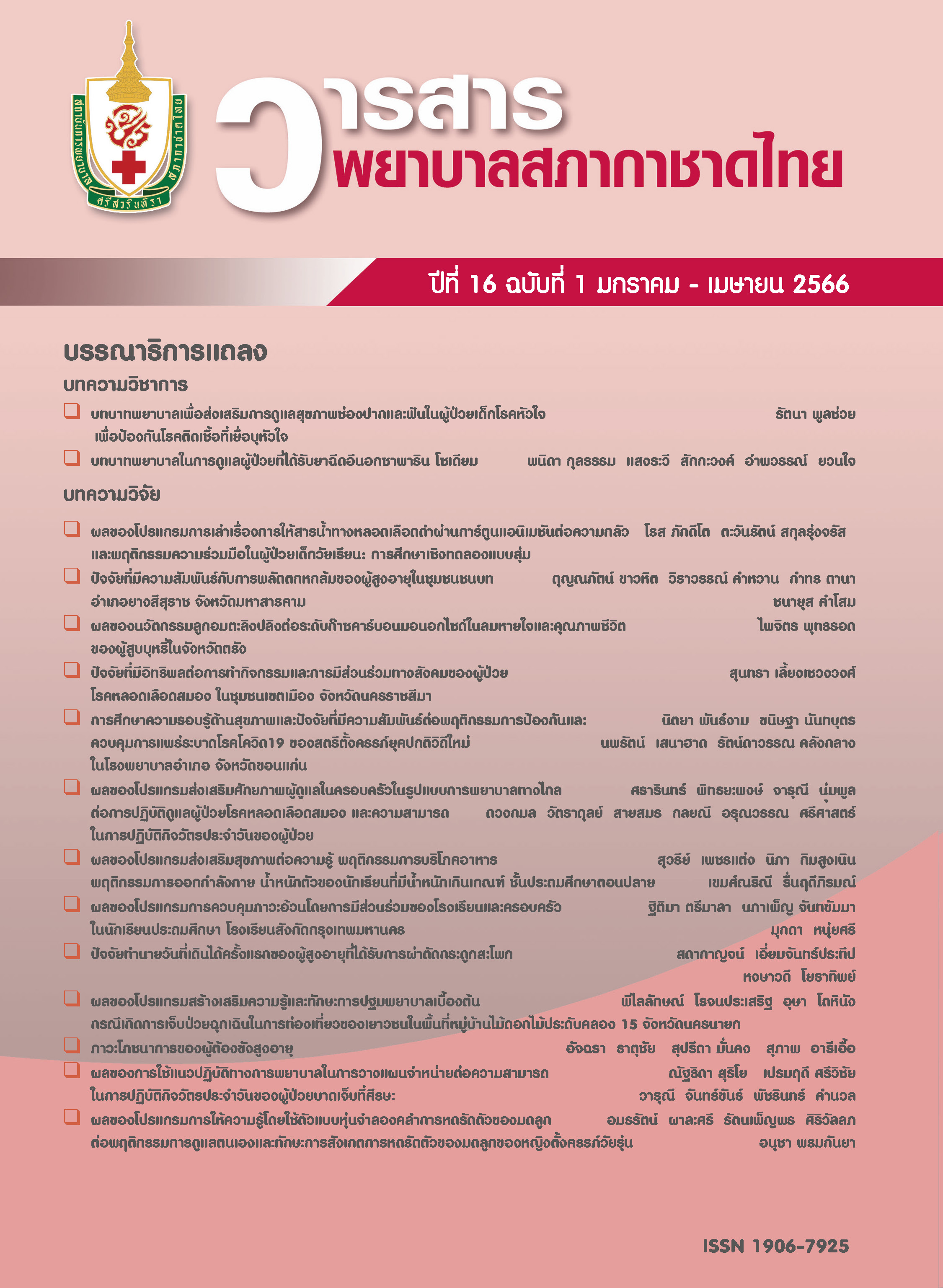The Effects of Discharge Planning Nursing Guidelines on Activities of Daily Living Among Patients with Traumatic Brain Injury
Keywords:
head injury, nursing practice guidelines, head injury patients, discharge planningAbstract
The objective of this study was to study the effects of discharge planning nursing guidelines on activities of daily living among patients with traumatic brain injury. Head injury patients admitted to the female surgery ward and male surgery, Phayao Hospital from October 2018 - December 2020, were selected to be the specific sample. Participants were divided into an experimental group (n = 38) and a control group (n = 38). The experimental group received care according to the discharge planning nursing guidelines among patients with traumatic brain injury from July to December 2020, and the control group was used for comparison. The control group received nursing care according to nursing standards prior to the development of discharge planning nursing guidelines among patients with traumatic brain injury from October 2018 - September 2019. Data were collected using questionnaires regarding discharge planning nursing guidelines among patients with traumatic brain injury and the consciousness scale using the Glasgow Coma Scale (GCS). Data were collected from medical records. Data were analyzed using descriptive statistics, Chi - square, The Mann - Whitney U test, and the independent t - test.
The result showed that the adoption of the guidelines resulted in an increase in the patients’ ability to perform daily activities more than the control group at a statistically significant level of .001. (p < .05).
Therefore, this study suggests that the guidelines should be applied in the organization and disseminated to other agencies to promote the recovery of patients with traumatic brain injury.
References
Keawcha - am R. Nursing of traumatic brain injury patients: holistic nursing. Chanthaburi: Pimrak; 2015. (in Thai)
Kopits E, Cropper M. Traffic fatalities and economic growth. Accid Anal Prev 2005;37(1):169 - 78.
World Health Organization. WHO global status report on road safety 2013: supporting a decade of action [Internet]. 2013 [cited 2023 Mar 6]. Available from: https://apps.who.int/iris/handle/ 10665/78256
Tantivisut S, Namvongprom A, Sirikul S. Effectiveness of nursing system development in using evidence - based protocol on quality of are in patients with severe traumatic brain Injury. Journal of Nurses' Association of Thailand, North - Eastern Division 2011;29(3):5 - 13. (in Thai)
Abelson - Mitchell N. Epidemiology and prevention of head injuries: literature review. J Clin Nurs 2008;17(1):46 - 57.
Statistics Working Group. Head injury statistics, Phayao Hospital. Phayao: Phayao Hospital; 2020. (in Thai)
Arabi YM, Haddad S, Tamim HM, Al - Dawood A, Al - Qahtani S, Ferayan A, et. al. Mortality reduction after implementing a clinical practice guidelines - based management protocol for severe traumatic brain injury. J Crit Care 2010;25(2):190 - 5. doi: 10.1016/j. jcrc.2009.05.004.
Boontua D. Effectiveness of care for patients with moderate head injury: Uthumphon Phisai Hospital [Internet]. 2012 [cited 2020 May 16]. Available from: http://utp.go.th/index. php/km/km - hos/category/29 - research - 2555
Lum P, Harnirattisai T, Tantongtip D. The effects of a continuing care program on the perceived self - efficacy of caregivers and post - concussion syndrome in persons with mild traumatic brain injury. Rama Nurs J 2019;25(1):58 - 70. (in Thai)
Issarapan K. Rojcheewin P. Development of a clinical nursing practice guideline for pre - operation in traumatic brain injury patients. Journal of Health Science 2016;25(5):823 - 30. (in Thai)
Givin J. Coaching for improving job performance and satisfaction. Nurs Times 1999; 95(50): 55-7.
Bumrungphan A, Ampon K, SilpKitcharoen P. The effects of using the predispense preparation model on professional nurses' responsibility for professional nursing and quality of life of patients stroke Phrapokklao Hospital. Journal of Nursing Division 2010;37(3):1 - 14. (in Thai)
Chantrakot P. The development of discharge planning model for patients with head injury. Journal of Nurses’ Association of Thailand, North - Eastern Division 2013;31(3):186 - 94. (in Thai)
Mahoney FI, Barthel DW. Functional evaluation: The Barthel Index. Md State Med J 1965;14:61 - 5.
Senasana S, Komjakraphan P, Isaramalai S. Develop for the home - based skill training program for caregivers of stroke patients. Journal of Preventive Medicine Association of Thailand 2017;7(2):212 - 22. (in Thai)
Polker V, Kongsiang A. Survival of patients with traumatic brain injury: emergency medical services (EMS) and non - EMS transport. Khon Kaen: Khon Kaen Hospital; 2016. (in Thai)
Kendall M, Cowey E, Mead G, Barber M, McAlpine C, Stott DJ, et al. Outcomes, experiences and palliative care in major stroke: a multicenter, mixed - method, longitudinal study. CMAJ 2018;190(9):E238 - 46. doi: 10.1503/cmaj.170604
Posai V, Jitpanya C. A component analysis of palliative care for stroke patient. J Med Health Sci 2020;27(2):62 - 72. (in Thai)
Lee JH, Ku J, Cho W, Hahn WY, Kim IY, Lee SM, et al. A virtual reality system for the assessment and rehabilitation of the activities of daily living. Cyberpsychol Behav 2003;6(4):383 - 88.
Tsai PF. A middle - range theory of caregiver stress. Nurs Sci Q 2003;16(2):137 - 45.
Katz S, Kravetz S, Grynbaum F. Wives’s coping flexibility, time since husbands’ injury and the perceived burden of wives of men with traumatic brain injury. Brain Inj 2005;19(1):59 - 66
Downloads
Published
Issue
Section
License
Copyright (c) 2023 Srisavarindhira Thai Red Cross Institute of Nursing

This work is licensed under a Creative Commons Attribution-NonCommercial-NoDerivatives 4.0 International License.
เนื้อหาบทความหรือข้อคิดเห็นต่างๆ ในวารสารพยาบาลสภากาชาดไทยนี้ เป็นความคิดเห็นของผู้เขียนบทความ ไม่ใช่ความเห็นของกองบรรณาธิการ หรือสถาบันการพยาบาลศรีสวรินทิรา สภากาชาดไทย






